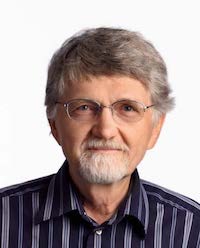Hans Reich
1943 – 2020
HANS J. REICH was born in 1943 in Danzig Germany, and emigrated to Canada in 1950. After earning a B.Sc. at the University of Alberta in 1964, he entered graduate school at UCLA. He received a Ph.D. with D. J. Cram in 1968. Reich met his future wife, Ieva, while they were both graduate students at UCLA. Reich spent two years doing postdoctoral work supported by a Canadian National Research Council Postdoctoral Fellowship, the first at Cal Tech with J. D. Roberts, and the second at Harvard with R. B. Woodward. In 1970 Reich joined the faculty at the University of Wisconsin — Madison. He was promoted to Associate Professor in 1976 and to full Professor in 1979. From 1975 – 1979 he held a Sloan Fellowship. Professor Reich has held visiting Professorships at the University of Marburg in Germany, the Louis Pasteur University in Strasbourg, France and the University of Alicante, Spain.
In the Chemistry Department Reich was Chair of Organic Division 1991-1999 and Associate Chair of the Department 1999-2005. His contributions to the Department and the UW-Madison campus more broadly were recognized via the Helfaer Professorship in Chemistry, the Professor James W. Taylor Excellence in Teaching Award (1994) and the University of Wisconsin Mid-Career Award (1995).
Reich’s scholarly achievements were recognized by the Arfvedson-Schlenck Prize (Lithium Award) sponsored by the German Chemical Society (2007) and the James Flack Norris Award in Physical Organic Chemistry sponsored by the American Chemical Society (2012).
In his 43 years as a faculty member Reich served as research supervisor for 39 Ph. D. students, 18 M.S. students and 59 undergraduate researchers. He published more than 150 papers in refereed journals, 9 review articles and 1 computer program. His most cited paper, on the selenoxide elimination, had received over 900 citations at the time of his death.
During his time at Wisconsin Reich taught a number of courses in the Chemistry Department both at the undergraduate level, where he initiated and regularly taught Chemistry 547, Advanced Organic Chemistry, and at the graduate level, where he taught Chemistry 605, Structure Determination Using Spectroscopic Methods (mainly NMR) annually from 1981 until after his retirement. This course was legendary among many generations of Wisconsin graduate students. Reich reached over 1000 chemists through an ACS continuing education short course, Frontiers of Organic Chemistry, from 1982 to 2007.
Reich’s research program was supported continuously by the National Science Foundation form 1972 to 2010, and sporadically by the National Institutes of Health (National Institute for Arthritis, Digestive Diseases and Kidneys, National Institute for Environmental Health Sciences), by grants from private funds and industrial sources.
Reich’s research program explored the synthetic and mechanistic aspects of organoselenium, organosilicon, and organolithium compounds. His efforts included smaller forays into organotellurium, organotin, organoantimony, organosulfur and organoiodine compounds.
Reich’s work in organoselenium chemistry was aimed at developing methods for performing previously difficult or impossible chemical transformations of organic molecules using the special properties of this element. One of the methods developed (the selenoxide elimination to form α,β-unsaturated carbonyl compounds and other alkenes) has become a standard procedure adopted by chemists throughout the world; this chemistry is covered in many undergraduate textbooks. Reich’s work with selenium compounds also contributed to understanding of the chemical aspects of the role this essential trace element plays in metabolism.
Reich’s work in the synthetic area was always supported and enhanced by clarifiying mechanistic studies, especially when an unexpected chemical event jeopardized the synthetic utility of the reactions being developed. When he became seriously interested in organolithium chemistry in the mid 1980’s his work took a decidedly stronger mechanistic organometallic turn. Reich’s experimentation, which made heavy use NMR spectroscopic investigations, contributed substantially to our understanding of the chemical behavior of these widely used, highly reactive and structurally complicated reagents. He firmly established the presence of multiple aggregation states and identified changes in structure and reactivity that occurred under different conditions. Reich’s students developed a Rapid-Inject NMR apparatus capable of operation down to –140 °C, and the group used this device to perform the first accurate measurements of the reactivity of specific oligomers, such as the dimer and tetramer of n-butyllithium, the monomer, dimer and tetramer of several enolates, and of oligomers of aryllithium reagents.
Reich had an extraordinary commitment to the assembly of data that would be broadly useful to organic chemists, and to making this information available to other scholars and students. The Division of Organic Chemistry of the American Chemical Society recently launched an Organic Chemistry Data website (organicchemistrydata.org) that is largely based on resources that Reich developed over many years. Other service to the scholarly community included many years of service on the Board of Editors for Organic Reactions.
Reich had an unusual and appealing personality. He was deeply insightful, and he was direct in his communications. As one colleague observed, Reich could explain to you why your favorite hypothesis could not possibly be correct in a way that didn’t leave you feeling bad. For this reason, he was widely sought among colleagues and students for advice and guidance. Hans Reich is deeply missed by his wife, fellow chemist Dr. Ieva Reich, his former students, his colleagues at UW-Madison and by friends and fellow scholars around the world.


